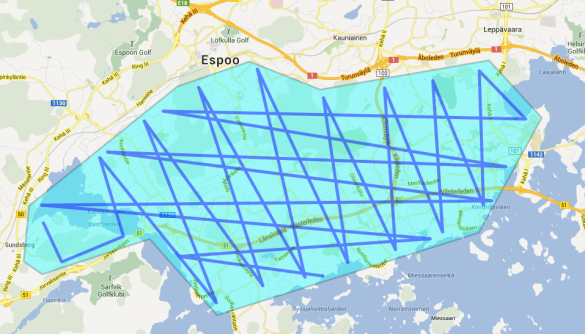I love subway and trams myself. They are electric, efficient and convenient means of transport.
The Helsinki capital region is building a lot of rail expansion lately. There’s Länsimetro (western metro) extending the existing metro line by 13,9 km. There’s Kehärata (Ring rail connecting to the airport) – also conveniently called Vantaa metro because it runs more underground than the current metro rail does – due to open in 2015. There’s Pisararata (a small but expensive underground terminal system in the heart of the city for local trains) still in planning stage.
And then there’s the “Länsimetro extension”, a further 7 km of track in Espoo.
I came across the specifics of the Länsimetro extension plan, lately, and was disturbed by some of the figures. Thus this blog post.
1. The price per km
Current estimate is 767 million euros (Meur) for the 7 km extension.
That itself should cause alarm bells to ring. It makes a whopping 109,6 Meur/km which by any figures I’ve seen is really costly. Compare to 800Meur/13,9km = 57,5 Meur/km for the ongoing Länsimetro work (which I believe to be fairly usual price range for metro tracks internationally). Why almost double the price? It’s an extension – it’s supposed to be cheaper, right?
Also, the push for doing the extension right now (as a continuation to the ongoing digging) has been reasoned by a claimed “100 million eur cost savings”. So the *real* price should be 867 Meur?
Something in this smells.
2. The need?
The second figures that caught my attention were the estimated passenger counts. By 2035, the peak traffic is estimated to be from 1300 to 4700 passengers per hour per direction (morning hours towards the center).

Passenger estimates for 2035 between various stations [1]
For the second, that’s remarkably little for subway, and especially such an expensive one.
For the third, even by the plans of the conservative HSL (Helsinki transport authority) by 2030 we should have automatic, light personal transport vehicles available.
Why make the extension?
3. Alternatives
During the planning phase multiple scenarios were drawn. Handling the extension with trams (which are cheaper) was considered, but turned down because of the problems incurred by passengers needing to switch transport modes. The thinking goes, too many people will continue to use their private cars, unless the metro by itself comes fairly close to their home door.
What was not noticed is that the problem in the transport chain (tram-metro-walk/train/bus/tram) is not incurred by having two modes. It’s incurred by having two timetables.
If there is a mode (which there is) that operates without timetables the uncertainties and much of the inconvenience of the “mode switch” disappears. You walk to the station near you, take the vehicle. Switch to metro (no much wait since they operate frequently). Deal with the mode switch at the other end, maybe.
I’ve used HSL extensively, and I know two mode switches is *not* good. Some days you are lucky – others not. But you must plan for the unlucky day, to reach in time. That’s why we need modes *without timetables* to extend metro systems.
So what would I have to offer?
Consider PRT [4]. There are three companies with ready-to-buy offerings out on the market. They will be able to cover this need, for a 10-20Meur/km price (dual-direction track). That’s 140 million. 627 million savings.
I find it peculiar that PRT was not even considered.
Or don’t do anything. Wait a couple of years. Better alternatives are being created. They will be smarter, lighter and – cheaper. Don’t waste 767 millions now to make a tube in the rock that no-one will need.
4. Capacity
To be frank, HSL probably thinks that 4700 pphpd (people-per-hour-per-direction) is over the top for PRT. It may be. There is no precise higher end to the PRT capacity, but it’s somewhere between 2000..5000 pphpd. Maybe the Finnoo-Matinkylä part really needs to be extended (for the 2035 time frame). Personally, I’m convinced that 3600 pphpd is completely reachable with the PRT technology. Without timetables. With operating costs not much higher than the metro’s.
Some initial proof can be received from the upcoming ULTra Amritsar [3] track in India which aims at 100 000 passengers / day capacity. That feels like extending PRT’s “roof” by some, but if they succeed, the Länsimetro extension can definitely be covered by PRT, by 2035. [Seems the Amritsar project is currently scrapped, due to complaints on its visual impact to the city scape and opposition from local taxi/rickshaw drivers. But we need not wait for India. 05-Mar-2014]
5. Service level
On the Länsimetro extension FAQ, the planners themselves admit that metro stations cannot be placed ideally, because of i.e. track layout issues. So it’s not even going to be optimal. In contrast, PRT tracks have rather small curvature (5-10m radius) and can be placed where it’s best for the passengers to enter them.
After all this, I was thinking hey what could be done with that 767 Meur if it’s used for something else than digging a tunnel?
This is what:

Coverage of an ultra light rail track (google maps sketch)
That’s covering *all* of Espoo below the Ring III and Rantarata train track. This encloses all the public transport concerns of the city: Espoo center, Suurpelto, Leppävaara, Tapiola, Otaniemi. It also covers the Sundsberg area on the Kirkkonummi side (the left end).
The blue line extends 172km in length. That gives a 4,45Meur/km price target if all that track was to be done using PRT. That’s an already reachable level. Much more so in the future.
Would Espoo city and its city-zens want this, or a 7km tunnel in rock?
Sources: [1] http://espoo04.hosting.documenta.fi/kokous/2012231182-7-4.PDF (Länsimetro extension project plan 2012; in Finnish) [2] http://www.lansimetronjatke.fi (Länsimetro extension web site; in Finnish) [3] http://www.ultraglobalprt.com/wheres-it-used/amritsar-india/ (ULTra Amritsar track) [4] http://en.wikipedia.org/wiki/Personal_rapid_transit (PRT at Wikipedia)